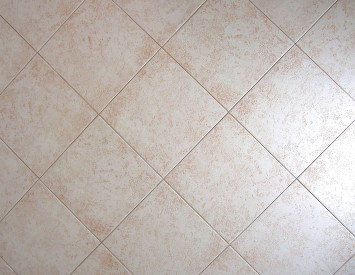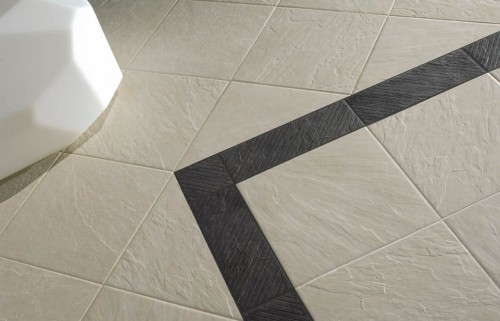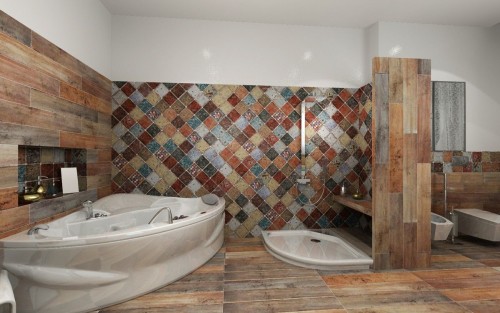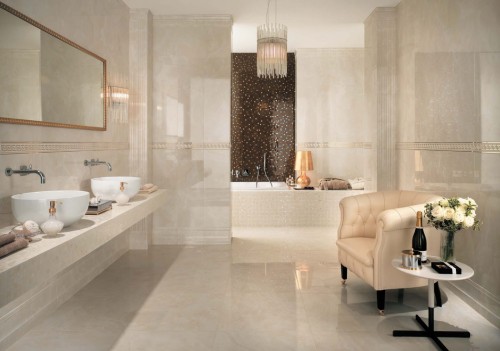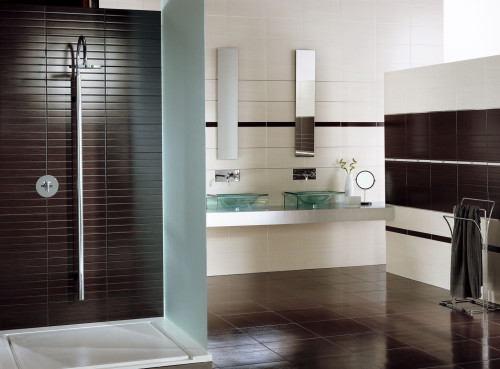Every year, artificial finishing materials are becoming more and more in demand. The thing is that natural products are much more expensive than artificial. Moreover, the second option is a little more practical in terms of use in the construction process. In fact, there are many positive aspects of these products, and gradually they become more and more significant.
Content
If we talk about the process of decorating the bathroom, then there is no large -scale choice of materials with which the space could be transformed. In most cases, ceramics are used, which has long established itself from the best side.
Now people want something original and interesting in their own way. In some cases, there is no need for cardinal changes, just slightly change the perception of space.
In this article, we will talk about porcelain stoneware - artificial finishing material, which is rightfully considered one of the most interesting decisions of recent years. Despite this name, the material still resembles classical ceramics more, but its characteristics and properties attract much more attention than the usual material for decorating the bathroom.
Also in the material we will consider the main scenarios related to the process of decoration of the bath, as well as the subtleties that are often found during this event.
Features and properties of porcelain
Porcelain stoneware has gained great prevalence recently. However, after the material went on sale in construction stores, it began to be used almost everywhere. This is a truly universal finishing material that is used both as the external decoration of the building and to decorate the walls inside the house. This wide application of the material is dictated by its properties.
Porcelain stoneware is carried out by the method of semi-dry pressing based on a press pod at high pressure, as well as high temperatures (up to 1300 degrees Celsius). The press porn itself can be obtained from the Schliker.
Despite this, on sale you can find more than a dozen types of tiles, each of which can be used in certain conditions. Among the main types of tiles, the following can be distinguished:
- Matte porcelain stoneware. This material is a tile with an unlawed surface. Accordingly, such material is best used for the exterior decoration of the building. Such products are resistant to precipitation and many other external influences.
- Polished porcelain stoneware. Most often, such a material has an almost mirror surface. Therefore, it can be used as a decoration of surfaces indoors. However, it must be borne in mind that polishing of porcelain tile is an expensive pleasure, and after some time the mirror layer will turn into matte.
- Satinated porcelain stoneware. Such material refers to decorative finishing resources. This porcelain tile has a wax base that does not slip, but at the same time differs in brilliance. Unfortunately, this type of material does not take high loads, so it is best to lay satinated porcelain tiles exclusively on internal wall surfaces.
- Technical porcelain stoneware. Outwardly, this material is almost identical to natural granite, but its properties are slightly different. It is called the technical for the reason that it is not subjected to additional processing. However, this does not interfere with the use of this material as an element for decorating a summer cottage or even the foundation of the home. The cost of such products is relatively low.
- Structured porcelain stoneware. This product has an original relief that allows you to successfully imitate the surface of the wood. Of course, you can easily create whole images and compositions, but for this you need to have special equipment. If there is a need to use such a material, you can contact a particular manufacturer (fortunately, there are many like that today) and order your original solution. Moreover, the relief on such a surface can resemble both fabric and even genuine skin. Everything is limited only by a price issue, and such a pleasure is expensive.
- Glazed porcelain stoneware. As you can understand from the name, this material has a fairly attractive surface, characterized by brilliance. This is true, however, after some time, the smoothness of such porcelain tile begins to be rapidly lost. But at the same time, the strength of this product is much higher than the same ceramic tiles. Thus, this is a great choice for those who most in such products value reliability and durability.
Dimensions of porcelain tiles
Porcelain stoneware can be found in almost every construction store, so you need to keep in mind that this material has a fixed size. More often on sale there are the following dimensions of products: 30x30 cm, 45x45 cm, as well as 60x60 cm.
If we talk about the thickness of porcelain tile, then it has almost any importance. The strength of thick and thin products is approximately the same. Therefore, for wall decoration, you can safely use material with a thickness of 3 mm. For the floor, slabs are suitable, the thickness of which is 8 mm. If we are talking about enterprises, then products with increased thickness should be used here, since there is a risk of cracks if a heavy object falls on the surface. Again, for the decor you can use the most fragile products, and with the correct styling technology, the material will never be damaged.
Advantages of porcelain tile over other finishing materials
If we talk about the decoration of the inner walls of the dwelling, then here the porcelain tile is not used so often. The exception is the bathroom, since it is there that increased humidity operates. Accordingly, the porcelain stoneware copes with this trouble very easily. But this is far from the only advantage of the material in comparison with many other decoration options. It should be noted the several most important advantages that classic porcelain tiles have:
- Strength and lack of cracks. Porcelain stoneware is very difficult to damage, and this is relevant specifically for the bathroom. If we are talking about ordinary ceramics, then this material is more fragile than porcelain stoneware. In the bathroom, it is easy to damage the finishing material, and this must always be borne in mind. Moreover, porcelain stoneware withstands high pressure on the surface.
- Low absorption of moisture. Again, it is very important for the bathroom that the finishing material does not absorb moisture, since the surface will gradually collapse. In turn, porcelain stoneware has an extremely low moisture absorption coefficient. This suggests that the action of moisture does not matter to him. At the same time, do not think that in such conditions, moisture does not pose any threat. It must be remembered that between the tiles of porcelain tiles there can be a small gap into which water can penetrate and thereby destroying the finish “from the inside”.
- An attractive appearance of the surface. Unlike many other finishing materials that gradually lose their initial shine and attractiveness, porcelain tile (often) for many years looks the same as on the day of purchase. The thing is that the surface of the material successfully counteract most of the influences that adversely affect not only the characteristics of the material, but also on its appearance. In this case, it still makes sense to care for the material. In this way, we can enjoy the novelty surface even longer.
- Simplicity of installation. This advantage will appeal to those who do not have much experience in conducting the process of wall cladding. Here we just need to be attentive and responsible, and any mistakes can be corrected in the process. Despite this, the difficulty of work can change somewhat depending on the place where it all happens. Thus, the instruction from professionals should first be obtained.
The process of laying porcelain tiles
Preparatory work
First of all, you need to know that the process of laying porcelain tile is carried out in clear temperature frames. Accordingly, it cannot be allowed that the air temperature drops below 10 degrees Celsius. Moreover, too high temperature can also bring a lot of problems, therefore, with more than 40 degrees, it is not worth carrying out the repair process. If these measures are carried out on the street (facade finish), then special attention should be paid to air temperature. Most often, such work is carried out in the summer.
Also, high humidity cannot be allowed. There should be no problems with this issue within the bathroom, but it is better not to use the bathroom over the next few days. It is especially impossible to allow sharp drops of humidity, since the entire repair process can fail because of this. Throughout the repair, it is best to close the doors and windows tightly to stabilize the situation even if the weather is changing the window.
Also at this stage, we need to think about the location of the material on the surface. You can use a marker or pencil to mark the walls and floor. In this case, it is necessary to take into account not only the dimensions of the material itself, but also the intervals that will be present between the tiles.
Materials and resources necessary for repair
Most often, the list of necessary materials (except for porcelain tile) is as follows:
- grinding for seams;
- silicone sealant;
- primer;
- crosses;
- glue for finishing material;
- water.
In the process, we will need a container for an adhesive solution, a drill for stirring a mixture, a grinder, a building level, as well as the most ordinary devices for measuring geometric sizes (ruler, roulette, etc.).
The main part of the work
- The process of laying porcelain tile begins with the application of the solution to the wall surface. It should be borne in mind that it is advisable to create a thin layer so that the mixture is quickly grasped.
- Application of the solution occurs using a creped spatula, and here you need to build up from the height of the teeth and dimensions of the tiles so that the laying process takes place most simply.
- As for the solution itself, it should be ordinary cement, but you need to ensure that there are no spaces and voids on the surface created for decoration, otherwise the whole finish may suffer from this.
- Laying tiles begins from the bottom up. Accordingly, the process is carried out in rows, while you do not need to rush, since the tile should be located at the same level. In order to control this process, you need to use the construction level. In addition, the same way to check the horizontal location of the tiles.
- If there is a need to create an interval between tiles, you need to use special crosses, which during styling are located around the entire perimeter. Accordingly, we get a fixed distance, and after the end of the process, the crosses can be easily removed. Each new row of tiles is laid only after the full setting of the previous one.
- In the last turn, cutting tiles is carried out. This procedure is carried out in places where the standard tile size is simply not suitable. In this case, either the most ordinary grinder or a tile cutter will help. If porcelain stoneware has too much thickness, then the last tool is unlikely to be useful.
- The last stage is the use of fugues to fill the space between the tiles. This procedure is carried out only after the cement is hardened. First you need to extract all the crosses located between the tiles and carry out the filling of the joints. It is best to use a rubber spatula in this process. Immediately after these works, you need to clean the surface, since the grout is guaranteed to get on the tile.
